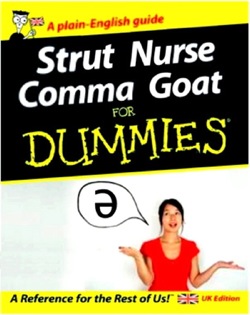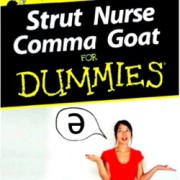STRUT for Dummies
 In a previous post I discussed the FOOT vowel of SSB, the rounded close-mid central vowel [ɵ]. This post looks at the central area below FOOT, a large area of the vowel space where we can find considerable variation in quality with little functional load in terms of word contrast.
In a previous post I discussed the FOOT vowel of SSB, the rounded close-mid central vowel [ɵ]. This post looks at the central area below FOOT, a large area of the vowel space where we can find considerable variation in quality with little functional load in terms of word contrast.
1. STRUT
This variability in lower-central vowel quality is not a recent phenomenon. For the old prestige accent Received Pronunciation (RP), Daniel Jones described the STRUT vowel as ʌ, “the HALF-OPEN BACK UNROUNDED vowel” (An Outline of English Phonetics; I’m using the downloadable first American edition of 1922). This is Jones producing his secondary cardinal 6, [ʌ]:
His own STRUT vowel sounds more central, [ʌ̈]:
And many RP speakers had a STRUT vowel still further from [ʌ], as exemplified in a clip which recently received attention on reddit.com, of the first ever broadcast in 1940 by the then Princess Elizabeth. We can hear her [ɐ] for STRUT in just, love, comes:
This [ɐ] vowel – which was quite widespread, as old recordings and films tell us – clearly overlaps with the international a vowel of Spanish and innumerable other languages. Jones acknowledged a as a (non-RP) pronunciation of STRUT, and even recommended it as a second-best realisation for foreigners:
If all efforts to obtain the precise sound ʌ fail, the best substitute is a, which bears a considerable resemblance to ʌ, and is actually used as a substitute for it in some English dialects (including London).
I agree with Jones’s pragmatic desire to help foreign learners, but [a] is no longer recommendable for STRUT, since it has become the contemporary TRAP vowel, thanks to the Anticlockwise Vowel Shift which differentiates contemporary SSB from RP. (The old RP æ became so stigmatized – or ridiculized – that even the Queen gradually shifted hers, as famously reported by Jonathan Harrington of the University of Munich.)
The less posh speakers of southern England have remained relatively conservative, retaining for STRUT the [ɐ] quality we heard from Princess Elizabeth. Here’s Kirk Norcross, from The Only Way Is Essex, saying “I was a bit gutted actually… I would love to do…”:
For SSB, however, STRUT has moved away from [a] and towards the triangle defined by ə-ʌ-ɑ. Such qualities can be heard from a single speaker. Emma Watson’s STRUT is most commonly a [ʌ̈] not unlike Daniel Jones’s, but it can slide towards [ə] or [ɑ]. Here are two pronunciations of lovely, both with nuclear intonational accents. The first is more [ʌ], the repetition more [ə]:
While this emphatic pronunciation of stunts might be confused with the word stance:
And here Kate Winslet with the same [ʌ]/[ə] variability:
2. commA
Jones defined the final vowel of commA as ə, “a MIXED [= central] UNROUNDED VOWEL, HALF-OPEN and SLIGHTLY LOWERED”, adding that “the average English ə is very similar in sound to ʌ“. He goes on:
It varies slightly in quality according to its position in the word, being distinctly opener when final…
Many English people actually use ʌ for ə when final, pronouncing bitter, clever as ˈbitʌ, ˈklevʌ. There is no objection to this pronunciation.
The recording of Princess Elizabeth exhibits this commA allophony, with a pre-pausal variant identical to the STRUT vowel, which for her was [ɐ]. This extends to the centring diphthongs; here are mother, Canada, Australia, remember, and share:
Again, we find that similar qualities are still alive and well in London/Estuary. Here’s Kirk Norcross from Essex saying older, singer, this year:
But as with Jones’s advice that [a] is acceptable in STRUT words, I’d resist his “no objection” attitude to the RP/Estuary allophony in commA syllables, which are more homogeneously [ə] in SSB today.
3. NURSE
[ə] also continues to be the most common quality for SSB NURSE. Jones transcribed it for old RP as əː, and John Wells’s Accents of English had the same view thirty years ago:
Phonetically, it is a relatively long unrounded mid central vocoid, [əː]
Which raises the question why the symbol “ɜ” is so widely used for it. I haven’t been able to find an explanation of “ɜ” in Accents of English (apologies if it’s there somewhere), aside from the 1979 IPA chart reproduced at the front of each volume, where it’s defined unhelpfully as “Variant of ə”.
“ɜ” is not, I think, a widely agreed-upon phonetic entity. Africanists use the symbol for an “advanced tongue root” (ATR) vowel, whereas the feature ±ATR is treated with diacritics on the current IPA charts. But the IPA now additionally gives “ɜ” its own plot of land on the vowel quadrilateral, immediately below schwa – which seems at odds with Jones’s view that the RP schwa has a jaw position “somewhat lower than in the case of the long əː.” And the current Wikipedia entry on the Vowel contains this curious statement, which shows that phonetic symbols can sometimes obfuscate more than elucidate:
The rarest vowels cataloged are ɜ (has just been cataloged in Paicî and Received Pronunciation English) and ʊ̈ (Early Modern English and Russian).
My impression is that using “ɜ” for the British NURSE vowel is chiefly a transcriptional sleight of hand to preserve the dogma that “schwa is never stressed”. In the reality of English, however, schwa can definitely be stressed. This is the case for the long monophthong of NURSE, and also for the first element of the GOAT diphthong.
I suspect that the “unstressable schwa” idea is popular because it’s simple, easily remembered and sounds authoritative. There may also be the good intention of reminding students about English vowel reduction. But it tends to instill or reinforce an assumption that schwa is a second-class vowel used only in casual or lazy speech, and therefore a low priority in learning. This profound misconception – nothing characterizes a foreign accent in English more than an absence of schwa – is so prevalent that Michael Ashby, Director of UCL’s Summer Course in English Phonetics, makes a point of contradicting it each year in his opening lecture.
A good schwa should be the foreign learner’s highest priority in pronouncing English. And learners aiming at a British accent will never produce native-sounding NURSE or GOAT vowels unless they can produce stressed schwa.
Of course, as I said at the beginning, variability is characteristic of the lower central vowel space of English, and this is found in both NURSE and GOAT. NURSE can be heard more open and back than [əː]; I tend to associate this with younger, relatively posh females. Listen to her said by Emma Watson:
4. GOAT
In GOAT, a fronted first element is widely perceived around the world as a key element in the stereotypical posh British accent. It was occasionally used by Princess Elizabeth, and has re-appeared more recently in the “GOAT fronting” which Emma Watson also sometimes uses:
Also common in the first element of GOAT is the same kind of relatively open pronunciation we heard as variants of commA and NURSE. We get this in London/Estuary; here Kirk Norcross says show and I dunno:
Daniel Radcliffe has a GOAT vowel which begins similarly, and can become more open and back under expressive emphasis:
Conclusions
Of course, the variability we hear in commA, NURSE, GOAT and STRUT is unsurprising, since vowel quality across these four lexical sets carries little or no functional load. NURSE, a long vowel, is distinct from the others in quantity. GOAT is distinct by virtue of its diphthongal trajectory. STRUT and commA are distinct from the other two by being short and monophthongal, and have practically no contrastive value with respect to each other: they’re defined in a mutually exclusive way, and alleged “minimal” pairs such as an equal and unequal are not structurally identical.
For many speakers in America, Wales, and England outside the southeast, commA and STRUT are not felt to be different vowels at all – though such speakers may differentiate an equal and unequal by means of stress. This is true of “educated Northerners” like me, and I suspect it lies behind the wide STRUT-variability of CNN’s weather anchor Jenny Harrison, born in Stratford-on-Avon:
Then there’s the ə/ʌ STRUT-variability of the Anglo-American pop-rock music through which many people around the world get most of their exposure to native English:
So, with all the variability across commA, NURSE, GOAT and STRUT, how do we follow Daniel Jones in attending to the needs of the general learner? What guidance can be offered to “Dummies” – in the sense of Wiley’s book series – the vast population of English learners who want phonetic help but not the fine detail which is the domain of specialists?
My basic philosophy is to teach the simplest system consistent with sounding native. So my advice to Dummies for commA, NURSE, GOAT and STRUT is to use ə in all of them: comm[ə], n[əː]s, g[əw]t and str[ə]t.
Like Jones, I teach English schwa as a somewhat lowered mid central vowel. To sound native, foreigners need to learn this vowel and be able to stress it and (for SSB) to lengthen it. And it must be kept distinct from both TRAP and PALM/START. This is not easy for most learners: happy is the English teacher whose foreign students have all mastered three qualities to differentiate Sam, psalm and sum/some. To insist on a fourth quality which has minimal functional value, and which is not necessary to sound standardly native, is in my opinion unnecessary for most learners.
Of course for more advanced students, or for actors aiming at a specific dialect, we can and should cover the “footnote” details: for example, that some speakers have a more open/back vowel in NURSE, or in GOAT, or in stressed STRUT syllables especially under emphasis. But, for Dummies, all four lexical sets can be treated as containing ə.

